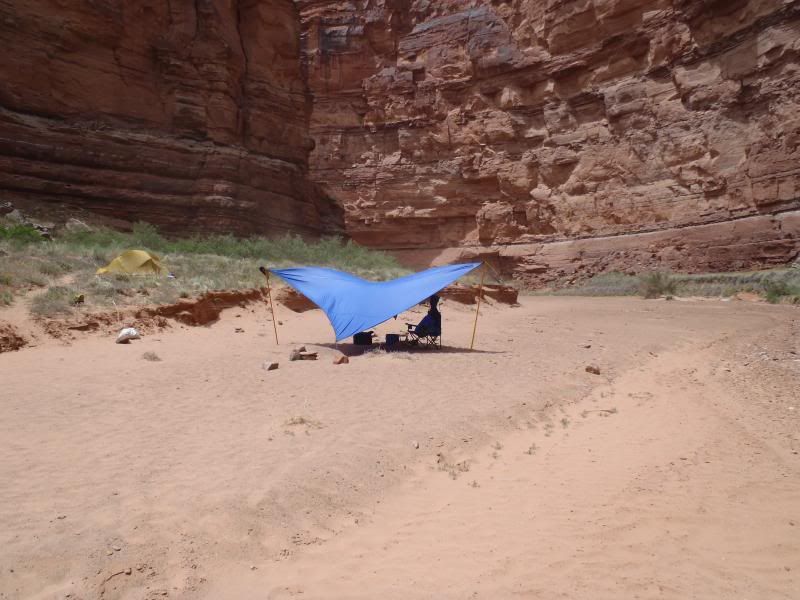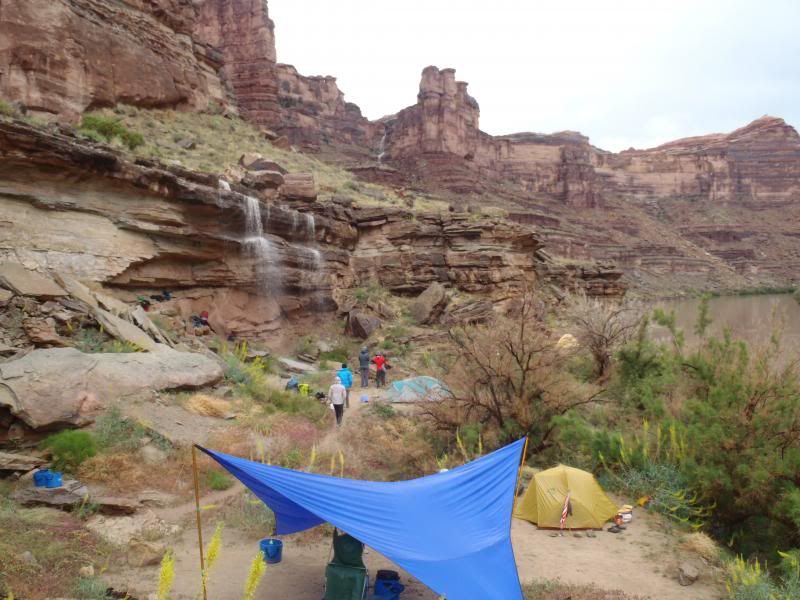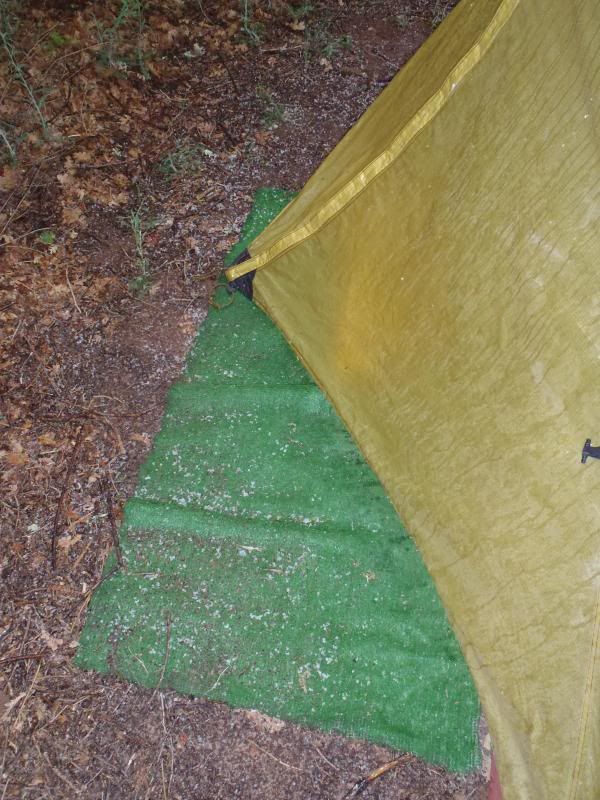- Joined
- Jan 17, 2016
- Messages
- 193
- Reaction score
- 26
I've never been much of a tarp guy. Not for a primary sleeping shelter, anyway. I mean, sure, string one up to sit under, play banjo under, eat supper under, but when the snow falls and the temperature drops or the creatures slither up from the soil or the skies open up I like the security of a tent. Or maybe the speed of a tent. Or the inside-ness of a tent when waiting out the storm. Which isn't exactly true either. If I'm east coast camping I now prefer the comfort and ease of a hammock, which does incorporate a bit of tarp alchemy, but it's the easy kind where you get to string up a line between two trees and pull the thing taut. And then the hammock gets me up off the ground away from the insidious creepy crawlies. The last tent I bought was in about 1998 and was called the Sierra Designs Omega, which was their "convertible" tent in which the inner wall could be zipped completely up for the cold, or opened onto mesh for the warm. The tent has never given me a single problem in 20 years and I still pull it out for bad winter weather, but it weighs in at a little over six pounds! Still, if you've ever been tent-bound for a few days, there's nothing like comfortably waiting on the weather surrounded by hot chocolate (splashed with whiskey), warm booties, and lots of words.
So yes, I have made brief forays into the art of tarping, and even picked up a bivy sack to stave off the worst of the weather whilst cowering under the sagging tarp, but I don't think I took it seriously enough to get proficient. Or efficient. Or sufficient. My tarping turned into the evening's activity, like of a sudden I'm journeying into the woods to spend the evening hours setting up the dang tarp, getting comfortable with tarp alchemy, getting my sleeping area mostly out of the rain, getting the proper angle against the wind, etc., meanwhile everything gets rained on, or my books fall into the snow. And then there is the fact that I simply don't enjoy spending lots of time setting up or breaking down camp. I'd rather walk or read or watch the water roll by. I may just be lazy. But hey, we all have our reasons for getting away from already practically being away from it all.
(When you wish you'd brought that tent...)
View attachment qbqk0Jkkt44SYxPUPMCdRdBTzTAo_CTl0FwekYM1N3Z00e9bZdIdMqomd1s7OOISyo2rkBDQ4ViQAE33kXTV0uNJM0eysAmziRl8
So but anyway, earlier this fall, after finally arriving at that happy place with the outfitting of the bulkhead in the new boat (yes, I had to find and then buy another boat recently as mine was stolen this summer by a gang of thieves), I spent a glorious weekend in West VA in an absolute downpour. Two days and two nights of near constant rain. And I'm not gonna lie: I'm just not a tarp guy. I fumbled with the stakes and paddles and knotted up cord I had carefully attached to each grommet, rain puddled and collapsed the paddles and when I finally crawled into my wet sleeping bag I was like: Yea, right.
I mean, don't hear me wrong. I've used the bivy on many occasions for quick overnighters, for going fast and light, and it works. But for extended trips? I think I'm ready to say officially NOT. (And I'm nearly certain that reading about Alan's forty days and forty nights of rain several months ago helped solidify my position on this.)
Something sort of registered. I've got a desert canyon trip coming up in about a month (actually 43 days 16 hours, but who's counting?) and hammock sleeping won't be feasible as the trees will be a tad sparse (and the nights will be a bit chilly), so I've been once again experimenting with the tarp/bivy. I figured the tarp would help keep the weight down as I'll be paddling through US Park Service land and therefore have to carry all their required supplies: groover, fire pan, helicopter signal panels, hand-washing system (?), extra PFD, etc... which actually turns into quite the pile of gear. So it's shaping up to be an eighteen day trip, and my boat is thirteen feet long and I've got 48" air bags on either end. Neither do I like a canoe that is loaded and sluggish, so limiting my available space for gear is a great way for me to cull only the necessary crap from the various piles of prospective wants and needs. But so I didn't buy an ultra-light sil-nylon tarp or anything, but simply stuffed my Eno rainfly into a compression sack with a bunch of those lightweight aluminum (0.46 oz.) tent stakes and threw in the OR bivy for when the rain really comes down. Then my nineteen year old son came in with his North Face Triarch 1 tent, including rainfly, footprint, and stakes, and beat the weight of my tarp/bivy by a few ounces. 2.7 lbs for a tent! "Why don't you just use this?" he said. And just like that, I gave up on the idea of a tarp.
I then asked him about the real possibility of borrowing his tent for a western trip and he said, "You got to do what you got to do." Which in my mind translates into: Absolutely, pops! Take it wherever you'd like for as long as you'd like!
And while the weather for my test run with the borrowed tent to my hometown river was indeed beautiful, and therefore probably inadequate on many levels for a true test of the tent's integrity, nonetheless the wide side entry door made access easy, the higher ceiling in the middle made sitting in the tent (even in my low chair!) comfortable, and the pole configuration made setting up a breeze. I suspect if I plan on being tent-bound in the snow for any length of time I would still probably prefer the Omega, but for a lightweight solo tent, there was room enough to be comfortable, and my struggles with solving the Rubik's Cube with my hands tied behind my back in the rain were pleasantly alleviated.
So yes, I have made brief forays into the art of tarping, and even picked up a bivy sack to stave off the worst of the weather whilst cowering under the sagging tarp, but I don't think I took it seriously enough to get proficient. Or efficient. Or sufficient. My tarping turned into the evening's activity, like of a sudden I'm journeying into the woods to spend the evening hours setting up the dang tarp, getting comfortable with tarp alchemy, getting my sleeping area mostly out of the rain, getting the proper angle against the wind, etc., meanwhile everything gets rained on, or my books fall into the snow. And then there is the fact that I simply don't enjoy spending lots of time setting up or breaking down camp. I'd rather walk or read or watch the water roll by. I may just be lazy. But hey, we all have our reasons for getting away from already practically being away from it all.
(When you wish you'd brought that tent...)
View attachment qbqk0Jkkt44SYxPUPMCdRdBTzTAo_CTl0FwekYM1N3Z00e9bZdIdMqomd1s7OOISyo2rkBDQ4ViQAE33kXTV0uNJM0eysAmziRl8
So but anyway, earlier this fall, after finally arriving at that happy place with the outfitting of the bulkhead in the new boat (yes, I had to find and then buy another boat recently as mine was stolen this summer by a gang of thieves), I spent a glorious weekend in West VA in an absolute downpour. Two days and two nights of near constant rain. And I'm not gonna lie: I'm just not a tarp guy. I fumbled with the stakes and paddles and knotted up cord I had carefully attached to each grommet, rain puddled and collapsed the paddles and when I finally crawled into my wet sleeping bag I was like: Yea, right.
I mean, don't hear me wrong. I've used the bivy on many occasions for quick overnighters, for going fast and light, and it works. But for extended trips? I think I'm ready to say officially NOT. (And I'm nearly certain that reading about Alan's forty days and forty nights of rain several months ago helped solidify my position on this.)
Something sort of registered. I've got a desert canyon trip coming up in about a month (actually 43 days 16 hours, but who's counting?) and hammock sleeping won't be feasible as the trees will be a tad sparse (and the nights will be a bit chilly), so I've been once again experimenting with the tarp/bivy. I figured the tarp would help keep the weight down as I'll be paddling through US Park Service land and therefore have to carry all their required supplies: groover, fire pan, helicopter signal panels, hand-washing system (?), extra PFD, etc... which actually turns into quite the pile of gear. So it's shaping up to be an eighteen day trip, and my boat is thirteen feet long and I've got 48" air bags on either end. Neither do I like a canoe that is loaded and sluggish, so limiting my available space for gear is a great way for me to cull only the necessary crap from the various piles of prospective wants and needs. But so I didn't buy an ultra-light sil-nylon tarp or anything, but simply stuffed my Eno rainfly into a compression sack with a bunch of those lightweight aluminum (0.46 oz.) tent stakes and threw in the OR bivy for when the rain really comes down. Then my nineteen year old son came in with his North Face Triarch 1 tent, including rainfly, footprint, and stakes, and beat the weight of my tarp/bivy by a few ounces. 2.7 lbs for a tent! "Why don't you just use this?" he said. And just like that, I gave up on the idea of a tarp.
I then asked him about the real possibility of borrowing his tent for a western trip and he said, "You got to do what you got to do." Which in my mind translates into: Absolutely, pops! Take it wherever you'd like for as long as you'd like!
And while the weather for my test run with the borrowed tent to my hometown river was indeed beautiful, and therefore probably inadequate on many levels for a true test of the tent's integrity, nonetheless the wide side entry door made access easy, the higher ceiling in the middle made sitting in the tent (even in my low chair!) comfortable, and the pole configuration made setting up a breeze. I suspect if I plan on being tent-bound in the snow for any length of time I would still probably prefer the Omega, but for a lightweight solo tent, there was room enough to be comfortable, and my struggles with solving the Rubik's Cube with my hands tied behind my back in the rain were pleasantly alleviated.




